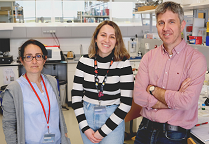The design and development of functional materials with tunable thermal conductivity — for example, to ensure the thermal dissipation in microelectronics devices — is necessary to prevent such devices from overheating. The ability to control the thermal conductivity of a material using an external stimulus, such as light, can increase the efficiency of thermoelectric energy conversion devices.
Researchers at the Center for Research in Biological Chemistry and Molecular Materials (CiQUS, Spain) revealed that the photoswitchable chemical compound, azobenzene, can be used to control the thermal conductivity of liquid crystals (LCs). Specifically, the researchers showed that doping LCs with azobenzene molecules can induce reversible changes in the LC’s thermal conductivity when the LC is irradiated with ultraviolet/visible (UV/Vis) light.
The discovery, they said, demonstrates the potential to develop effective thermal switches based on molecular materials.
“What we have done in this work is to demonstrate that we can use light-sensitive molecular motors to, once inserted into conventional liquid crystals, modify their structure — their molecular arrangement — and vary their thermal conductivity,” researcher Francisco Rivadulla told Photonics Media. “This change is completely reversible: It is only necessary to deactivate the molecular machine so that the LC returns to its original structure.”
Molecular motors, or molecular machines, demonstrate the ability to change properties such as shape in response to an external stimulus. Noa Varela, a Ph.D. student at CiQUS and first author of the study, said that thermal conductivity can be switched bidirectionally in the azobenzene-doped LCs. "Depending on the molecular arrangement of the liquid crystal, either an increase or decrease of thermal conductivity can be achieved upon illumination,” she said.
This increase or decrease can take place at room temperature, she said.

From left: Principal investigator María Giménez, researcher Noa Varela, and professor Francisco Rivadulla. The researchers introduced a materials-based method to control thermal dissipation in devices, including microelectronics devices. The advancement could prevent such devices from overheating. Courtesy of CiQUS.
The researchers synthesized azobenzene derivatives and continuously monitored the thermal conductivity-temperature of the azobenzene derivatives in a cryostat during heating/cooling cycles. In the case of one film that the researchers investigated, irradiation with UV light at room temperature transformed the azobenzene-doped LC into a cis isotropic liquid, with a reduction of the thermal conductivity. Once UV irradiation was stopped, this phase change remained stable for hours in the dark, before recovering to the original phase after thermal relaxation of the cis azobenzene isomer.
Recovery of thermal conductivity could be accelerated by irradiating the isotropic liquid with visible light, the researchers found. They repeated this process many times, demonstrating reversibility.
The researchers ultimately demonstrated up to 40% reversible switching of the thermal conductivity of photochromic azobenzene derivatives using isothermal UV/Vis illumination. The research results indicated that the photochromic azobenzene molecules could act as light-driven molecular machines that reversibly operate over the bulk order of conventional LC mesophases, allowing reversible access to more than two thermal states.
In addition, the researchers said, the large variety of available LCs, each offering different mesophases that could be accessed through doping with chemically compatible photoactive molecules, could lead to the design of molecular materials that offer multiple thermal states, all accessible at room temperature.
The research was published in Journal of Materials Chemistry C (https://pubs.rsc.org/en/content/articlehtml/2023/tc/d3tc00099k).